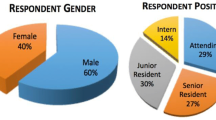Abstract
Introduction
Managing postoperative pain requires an individualized approach in order to balance adequate pain control with risk of persistent opioid use and narcotic abuse associated with inappropriately outsized narcotic prescriptions. Shared decision-making has been proposed to address individual pain management needs. We report here the results of a quality improvement initiative instituting prescribing guidelines using shared decision-making and preoperative pain expectation and management education to decrease excess opioid pills after surgery and improve patient satisfaction.
Methods
Pre-intervention prescribing habits were obtained by retrospective review perioperative pharmacy records for patients undergoing general surgeries in the 24 months prior to initiation of intervention. Patients scheduled to undergo General Surgery procedures were given a survey at their preoperative visit. Preoperative education was performed by the surgical team as a part of the Informed Consent process using a standardized handout and patients were asked to choose the number of narcotic pills they wished to obtain within prescribing recommendations. Postoperative surveys were administered during or after their 2-week postoperative visit.
Results
131 patients completed pre-intervention and post-intervention surveys. The average prescription size decreased from 12.29 oxycodone pills per surgery prior to institution of pathway to 6.80 pills per surgery after institution of pathway (p < 0.001). The percentage of unused pills after surgery decreased from an estimated 70.5% pre-intervention to 48.5% (p < 0.001) post-intervention. 61.1% of patients with excess pills returned or planned to return medication to the pharmacy with 16.8% of patients reporting alternative disposal of excess medication. Patient-reported satisfaction was higher with current surgery compared to prior surgeries (p < 0.001).
Conclusion
Institution of procedure-specific prescribing recommendations and preoperative pain management education using shared decision-making between patient and provider decreases opioid excess burden, resulting in fewer unused narcotic pills entering the community. Furthermore, allowing patients to participate in decision-making with their provider results in increased patient satisfaction.
Graphical abstract




Similar content being viewed by others
References
Feinberg AE, Chesney TR, Srikandarajah S, Acuna SA, McLeod RS (2018) Opioid use after discharge in postoperative patients: a systemic review. Ann Surg 267(6):1056–1062
Michigan-open.org/prescribing-recommendations. Viewed 2/21/2021. Last updated 2/25/2020
Statement on the Opioid Abuse Epidemic. Approved by ACS Board of Regents June 2017. Online August 2, 2017. https://www.facs.org/about-acs/statements/100-opioid-abuse.
Vilkins AL, Sahara M, Till SR et al (2019) The effect of shared decision-making on opioid prescribing after hysterectomy. Obstet Gynecol 134(4):823–833
Fuji MH, Hodges AC, Russell RL, Roensch K, Beynnon B, Ahern TP, Holoch P, Moore JS, Ames SE, MacLean CD (2018) Post-discharge opioid prescribing and use after common surgical procedures. J Am Coll Surg 226(6):1004–1012
Waljee JF, Li L, Brummett CM, Englesbee MJ (2017) Iatrogenic opioid dependence in the United States: are surgeons the gatekeepers? Ann Surg 265:728–730
Clarke H, Soneji N, Ko DT, Yun L, Wijeysundera DM (2014) Rates and risk factors for prolonged opioid use after major surgery: population based cohort study. BMJ 348:g1251
Alam A, Gomes T, Zheng H, Mamdani MM, Jurrlink DN, Bell CM (2012) Long-term analgesic use after low-risk surgery: a retrospective cohort study. Arch Intern Med 172(5):425–430
El-Kafraoui C, Olleik G, Chay MA, Kouyoumdjian A, Nguyen-Powanda P, Rajabiyazdi F, Do U, Derksen A, Landry T, Amar-Zifkin A, Ramanakumar AV, Martel MO, Baldini G, Feldman L, Fiore JF (2020) Opioid versus opioid-free analgesia after surgical discharge: protocol for systematic review and meta-analysis. BMJ Open 10(1):e035443
Soneji N, Clarke HA, Ko DT, Wijeysundera DM (2016) Risks of developing persistent opioid use after major surgery. JAMA Surg 151(11):1083–1084
Goel A, Feinberg A, McGuiness B, Brar S, Srikandarajah S, Pearsall E, McLeod R, Clarke H (2020) Postoperative opioid-prescribing patterns among surgeons and residents at university-affiliated hospitals: a survey study. Can J Surg 68(1):E1-8
Hsia H, Takemoto S, Raghunathan K (2018) Acute pain is associated with chronic opioid use after total knee arthroplasty. Reg Anesth Pain Med 43(7):705–711
Hunyh V, Colborn K, Christian N, Rojas K, Nehler M, Bronsert M, Cumbler E, Ahrendt G, Tevis S (2020) Resident opioid prescribing habits do not reflect best practices in the post-operative pain management: an assessment of the knowledge and education gap. J Surg Educ S1931–7204(20):30484
Bicket MC, Long JJ, Pronovost PJ, Alexander GC, Wu CL (2017) Prescribing opioid analgesics commonly unused after surgery: a systemic review. JAMA Surg 157(11):1066–1071
Garbutt JM, Kulka K, Dodd S, Sterkel R, Plax R (2019) Opioids in adolescent’s homes: prevalence, caregiver attitudes, and risk reduction opportunities. Acad Pediatr 19(1):103–108
Anderson M, Hallway A, Brummett C, Waljee J, Englesbe M, Howard R (2021) Patient-reported outcomes after opioid-sparing surgery compared with standard of care. JAMA Surg 156(3):286–287
Barry MJ, Edgman-Levitan S (2012) Shared decision-making—the pinnacle of patient-centered care. NEJM 366:780–781
Acknowledgements
We would like to thank Dr. Amer Mujkanovic, Dr. Reginald Swift, and Stacy Arrazcaeta of Rubix Life Sciences for their statistical analysis. We would also like to thank the employees of the Dwight D Eisenhower Army Medical Center, including Hospital Command, Same Day Surgery/Preoperative Clinic, Post-Anesthesia Care Unit, and General Surgery clinic. We would especially like to thank the General Surgery attending surgeons and residents for their significant effort to institute this intervention.
Author information
Authors and Affiliations
Corresponding author
Ethics declarations
Disclosures
The authors Dr. Ciampa, Dr. Sherman, Dr. Liang, Dr. O’Hara, and Dr. Joel have no conflicts of interest or financial ties to disclose and no affiliations with or involvement in any organization with financial interest in the subject matter or materials discussed in this presentation.
Additional information
Publisher's Note
Springer Nature remains neutral with regard to jurisdictional claims in published maps and institutional affiliations.
The views expressed in this publication are those of the authors and do not necessarily reflect the official policy or position of the Department of the Army, the Department of Defense, nor the U.S. Government.
Rights and permissions
About this article
Cite this article
Ciampa, M.L., Liang, J., O’Hara, T.A. et al. Shared decision-making for postoperative opioid prescribing and preoperative pain management education decreases excess opioid burden. Surg Endosc 37, 2253–2259 (2023). https://doi.org/10.1007/s00464-022-09464-8
Received:
Accepted:
Published:
Issue Date:
DOI: https://doi.org/10.1007/s00464-022-09464-8




